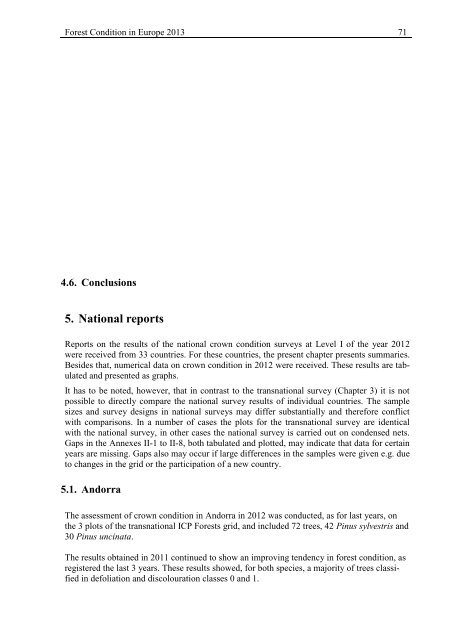Forest Condition in Europe - ICP Forests
Forest Condition in Europe - ICP Forests
Forest Condition in Europe - ICP Forests
You also want an ePaper? Increase the reach of your titles
YUMPU automatically turns print PDFs into web optimized ePapers that Google loves.
<strong>Forest</strong> <strong>Condition</strong> <strong>in</strong> <strong>Europe</strong> 2013 71<br />
Moreover, Vanguelova et al. (2010) found SO 4 — decrease that were significant at only 4 out<br />
of 10 plots for bulk deposition but at 8 out of 10 plots for throughfall deposition <strong>in</strong> the<br />
monthly 1995 to 2006 deposition data <strong>in</strong> UK. In bulk deposition the background level of sea<br />
salt sulphur deposition might be relatively high at ? some of the costal plots <strong>in</strong> UK. Same<br />
magnitudes of absolute decreas<strong>in</strong>g trends might thus result <strong>in</strong> lower relative slopes of the<br />
trends at these sites, especially for bulk deposition.<br />
Fagerli et al. (2008) compared NO 3 - and NH 4 + concentration <strong>in</strong> wet precipitation modelled by<br />
EMEP based on the emissions <strong>in</strong>ventories with measurements for the period from 1980 or<br />
later to 2003 and various sites <strong>in</strong> <strong>Europe</strong>. They also found decreas<strong>in</strong>g trends be<strong>in</strong>g significant<br />
for about half of the sites for both modelled and measured data. The significant decreases<br />
ranged from about 20% to 60% <strong>in</strong> 20 years, correspond<strong>in</strong>g thus to relative slope of about 1%<br />
to 6% a -1 . However, most of the reductions seem to have taken place <strong>in</strong> the years between<br />
1985 and 1995. Other reasons for decreas<strong>in</strong>g deposition are changes <strong>in</strong> the tree stand structure,<br />
such as the reduction of the number or trees due to a bark beetle attack that occurred on a<br />
Czech plot (2161).<br />
However, atmospheric deposition values presented here are restricted to bulk and throughfall<br />
deposition fluxes of <strong>in</strong>organic compounds. Total deposition to forests also <strong>in</strong>cludes organic<br />
compounds, stemflow, as wells as canopy uptake. Especially for nitrogen, total deposition<br />
typically is significantly higher than the throughfall fluxes.<br />
4.6. Conclusions<br />
5. National reports<br />
Reports on the results of the national crown condition surveys at Level I of the year 2012<br />
were received from 33 countries. For these countries, the present chapter presents summaries.<br />
Besides that, numerical data on crown condition <strong>in</strong> 2012 were received. These results are tabulated<br />
and presented as graphs.<br />
It has to be noted, however, that <strong>in</strong> contrast to the transnational survey (Chapter 3) it is not<br />
possible to directly compare the national survey results of <strong>in</strong>dividual countries. The sample<br />
sizes and survey designs <strong>in</strong> national surveys may differ substantially and therefore conflict<br />
with comparisons. In a number of cases the plots for the transnational survey are identical<br />
with the national survey, <strong>in</strong> other cases the national survey is carried out on condensed nets.<br />
Gaps <strong>in</strong> the Annexes II-1 to II-8, both tabulated and plotted, may <strong>in</strong>dicate that data for certa<strong>in</strong><br />
years are miss<strong>in</strong>g. Gaps also may occur if large differences <strong>in</strong> the samples were given e.g. due<br />
to changes <strong>in</strong> the grid or the participation of a new country.<br />
5.1. Andorra<br />
The assessment of crown condition <strong>in</strong> Andorra <strong>in</strong> 2012 was conducted, as for last years, on<br />
the 3 plots of the transnational <strong>ICP</strong> <strong>Forest</strong>s grid, and <strong>in</strong>cluded 72 trees, 42 P<strong>in</strong>us sylvestris and<br />
30 P<strong>in</strong>us unc<strong>in</strong>ata.<br />
The results obta<strong>in</strong>ed <strong>in</strong> 2011 cont<strong>in</strong>ued to show an improv<strong>in</strong>g tendency <strong>in</strong> forest condition, as<br />
registered the last 3 years. These results showed, for both species, a majority of trees classified<br />
<strong>in</strong> defoliation and discolouration classes 0 and 1.
















